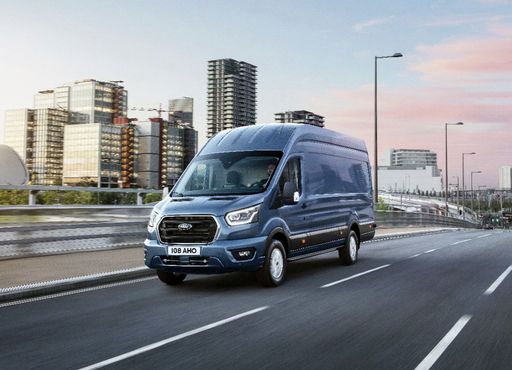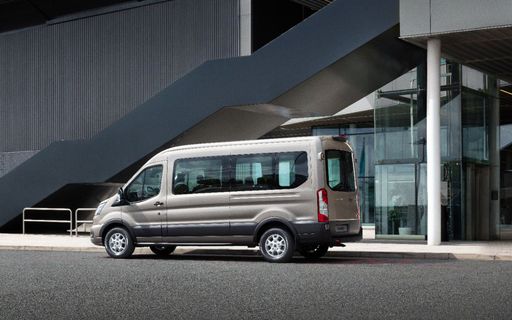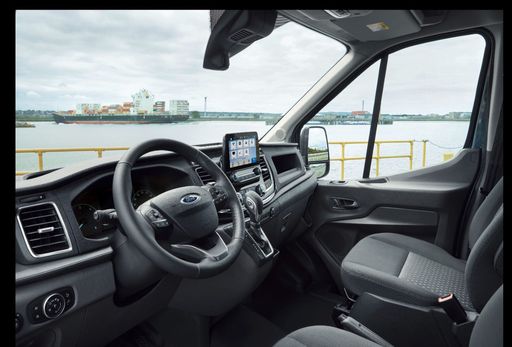Ford Transit Bus vs Nissan Primastar Bus – Differences & prices compared
Compare performance, boot space, consumption and price in one view.
Find out now: which car is the better choice for you – Ford Transit Bus or Nissan Primastar Bus?
The Ford Transit Bus (Bus) comes with a Diesel engine and Automatic transmission. In comparison, the Nissan Primastar Bus (Bus) features a Diesel engine with Manuel or Automatic transmission.
When it comes to boot capacity, the Ford Transit Bus offers 0 L, while the Nissan Primastar Bus provides – depending on how much space you need. If you’re looking for more power, decide whether the 150 HP of the Ford Transit Bus or the 170 HP of the Nissan Primastar Bus suits your needs better.
In terms of consumption, the values are 9.40 L per 100 km for the Ford Transit Bus, and 6.90 L for the Nissan Primastar Bus.
Price-wise, the Ford Transit Bus starts at 50500 £, while the Nissan Primastar Bus is available from 38500 £. Compare all the details and find out which model fits your lifestyle best!
Ford Transit Bus
The Ford Transit Bus is renowned for its robust performance and spacious interior, making it an ideal choice for both commercial and personal use. With its efficient handling and modern design, it effortlessly combines practicality with comfort. Its adaptability and versatility ensure it meets the demands of various driving needs, from urban transport to long-distance journeys.
details @ media.ford.com
@ media.ford.com
 @ media.ford.com
@ media.ford.com
 @ media.ford.com
@ media.ford.com
Nissan Primastar Bus
The Nissan Primastar Bus offers a comfortable and versatile driving experience ideal for both urban and long-distance journeys. Its interior is spacious and well-designed, providing ample room for passengers and luggage. With a focus on practicality and efficiency, this vehicle is a solid choice for families and businesses alike.
details

|
|
|
|
|
Costs and Consumption |
|
|---|---|
|
Price
50500 - 52900 £
|
Price
38500 - 63200 £
|
|
Consumption L/100km
9.4 - 9.5 L
|
Consumption L/100km
6.9 - 8.8 L
|
|
Consumption kWh/100km
-
|
Consumption kWh/100km
-
|
|
Electric Range
-
|
Electric Range
-
|
|
Battery Capacity
-
|
Battery Capacity
-
|
|
co2
245 - 248 g/km
|
co2
182 - 232 g/km
|
|
Fuel tank capacity
70 L
|
Fuel tank capacity
80 L
|
Dimensions and Body |
|
|---|---|
|
Body Type
Bus
|
Body Type
Bus
|
|
Seats
9
|
Seats
6 - 9
|
|
Doors
4
|
Doors
4 - 5
|
|
Curb weight
2338 - 2385 kg
|
Curb weight
1952 - 2527 kg
|
|
Trunk capacity
0 L
|
Trunk capacity
-
|
|
Length
5531 - 5981 mm
|
Length
5080 - 5480 mm
|
|
Width
2059 mm
|
Width
1956 mm
|
|
Height
2530 - 2533 mm
|
Height
1935 - 2040 mm
|
|
Payload
1115 - 1162 kg
|
Payload
543 - 994 kg
|
Engine and Performance |
|
|---|---|
|
Engine Type
Diesel
|
Engine Type
Diesel
|
|
Transmission
Automatic
|
Transmission
Manuel, Automatic
|
|
Transmission Detail
Automatic Gearbox
|
Transmission Detail
Manual Gearbox, Dual-Clutch Automatic
|
|
Drive Type
Front-Wheel Drive
|
Drive Type
Front-Wheel Drive
|
|
Power HP
130 - 150 HP
|
Power HP
110 - 170 HP
|
|
Acceleration 0-100km/h
-
|
Acceleration 0-100km/h
10.6 - 13.6 s
|
|
Max Speed
-
|
Max Speed
161 - 186 km/h
|
|
Torque
360 - 390 Nm
|
Torque
300 - 380 Nm
|
|
Number of Cylinders
4
|
Number of Cylinders
4
|
|
Power kW
96 - 110 kW
|
Power kW
81 - 125 kW
|
|
Engine capacity
1995 cm3
|
Engine capacity
1997 cm3
|
General |
|
|---|---|
|
Model Year
2024
|
Model Year
2022 - 2024
|
|
CO2 Efficiency Class
G
|
CO2 Efficiency Class
G
|
|
Brand
Ford
|
Brand
Nissan
|
Ford Transit Bus
The Versatile Ford Transit Bus from Ford
The Ford Transit Bus has always been a leader in the category of commercial passenger vehicles, and the 2024 model continues this legacy with a blend of reliability, innovation and modern design. With a range of configurations, the Ford Transit Bus is aimed at meeting the needs of businesses and individuals who require a spacious, dependable mode of transport.
Under the Bonnet: Technical Mastery
Power comes from a 2.0 EcoBlue diesel engine, available in power outputs of 130 and 150 PS. The engine is combined with an automatic transmission, ensuring a smooth drive even when fully laden. This Euro 6 compliant powerplant is designed for efficiency without sacrificing performance, sporting a fuel consumption range of 9.4 to 9.5 L/100km and an associated CO2 output of 245 to 248 g/km. Such numbers ensure that the Ford Transit Bus strikes a balance between power and economy.
Room to Spare: Exceptional Capacity and Comfort
The Ford Transit Bus is not just about getting from A to B; it’s about transporting passengers with utmost comfort. Depending on the specifications, the bus can accommodate between eight to nine passengers. The spacious interior is accompanied by an array of comfort features under the ‘Trend Automatik’ trim level, offering a practical and enjoyable ride experience for both drivers and passengers alike.
Dimensions and Practicality
Designed with practicality in mind, the Ford Transit Bus boasts dimensions that are fully suited to a variety of professional needs. Its length ranges from 5531 to 5981 mm, with a consistent width of 2059 mm and a height range from 2530 to 2533 mm. This translates to a generous loading capacity with a payload ranging from 789 to 1162 kg, making it a versatile option for businesses requiring ample cargo space alongside passenger accommodation.
Advanced Technology for Modern Roads
Aside from its primary function as a people mover, the Ford Transit Bus also shines with its technological prowess. It integrates advanced driver assistance systems aimed at ensuring both active and passive safety. This includes features that help drivers navigate through complex traffic situations and ensure maximum safety for all passengers.
A Smart Investment
The Ford Transit Bus is a competitive contender in its segment, offering not just performance and reliability but also reasonable costing. With monthly running costs ranging from €1,654 to €1,730 and cost per kilometre between 66.2 and 69.2 cents, businesses can expect an affordable operation without unexpected hikes in upkeep costs.
In conclusion, the Ford Transit Bus remains a clear front-runner among its peers, offering a combination of cutting-edge technology, impressive fuel efficiency, and a spacious, comfortable interior. Whether you are looking to enhance your fleet or need a robust transport solution, the Ford Transit Bus is a sound choice for the discerning buyer in 2024.
Nissan Primastar Bus
The Nissan Primastar Bus: A Versatile Contender
The Nissan Primastar Bus stands out in the bustling world of light commercial vehicles, offering an impressive blend of functionality and modern technology. With its versatile design and a range of powerful diesel engines, this vehicle meets the demands of both business and leisure travel.
Engine Performance and Efficiency
At the heart of the Nissan Primastar Bus is a robust diesel engine, available in two power variants: 150 PS and 170 PS. Both options deliver a smooth ride with front-wheel drive, ensuring excellent road handling. Despite its size, the Primastar maintains fuel efficiency, with consumption figures ranging from 7 to 7.2 litres per 100 km, making it an economic choice for long-distance drives.
Innovative Transmission Options
The Primastar Bus offers flexibility with both manual and automatic transmission choices. The manual gearbox provides a traditional driving experience, whereas the automatic option, featuring a dual-clutch system, enhances driving comfort and efficiency, particularly in urban settings.
Spacious and Practical Design
Designed to accommodate up to nine passengers, the Nissan Primastar Bus ensures ample space and comfort. Its dimensions, with a length between 5080 mm and 5480 mm, width of 1956 mm, and height of 1935 mm, afford generous interior space while maintaining a manageable footprint on the road.
Advanced Safety Features
Safety is a paramount concern for any passenger vehicle, and the Primastar Bus doesn't disappoint. It includes a range of safety features aimed at protecting both the driver and passengers, making it a reliable choice for family or business transport.
Technological Advancements
Equipped with the latest in automotive technology, the Primastar Bus boasts a modern infotainment system, allowing seamless connectivity, navigation, and entertainment throughout your journey. Its user-friendly interface and smart integrations enhance the overall driving experience.
Overall Value and Cost
Priced between €51,765 and €57,370, the Nissan Primastar Bus offers great value for money, combining innovative engineering with practicality and affordability. Its competitive pricing, paired with exceptional fuel efficiency, makes it a cost-effective solution for various transportation needs.
In conclusion, the 2024 Nissan Primastar Bus is a testament to Nissan's commitment to delivering versatile, efficient, and reliable vehicles, capable of handling a myriad of roles with ease. Its perfect blend of power, space, and innovation ensures it stands out as a formidable choice in the commercial vehicle segment.
The prices and data displayed are estimates based on German list prices and may vary by country. This information is not legally binding.
